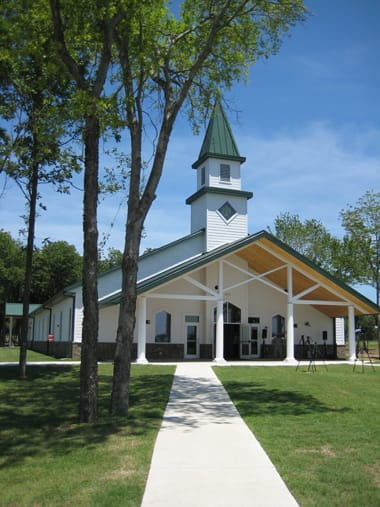BY KIRBY LEE DAVIS

BRAGGS – It resembles something from an old movie set: a white frontier church, its steeple stretching 57 feet into the prairie sky.
“It stands very prominent amongst the trees,” architect Glenn Short said of Camp Gruber’s nearly 10,500-square-foot Thunderbird Chapel. “It’s sited so that it will look towards the barracks facilities and their future barracks.”
That’s a key point since the chapel, opened this spring, serves as Gruber’s only dedicated sanctuary — its first since that Oklahoma National Guard post was reactivated in 1977.
It wasn’t always that way. As one of 84 U.S. military training camps launched from 1941 to 1942, the Braggs complex grew to have 14 churches among its 1,000-plus buildings. But with the camp’s 1947 decommissioning, nearly all of those structures, including all of the churches, were either taken down or relocated.
It took Gov. Mary Fallin’s 2010 election to change that. When she learned of the camp’s deficiency, Fallin formed a commission to give Gruber a dedicated sanctuary this year, so that Oklahoma soldiers returning home from overseas service would have a place to help them find peace.
“We had some people that worked 14 to 15 hours a day, seven days a week, to keep it on schedule,” said Shepherd, president of Oklahoma Roofing and Sheet Metal. “The Associated General Contractors, they were a big help. I went to them again and again and again.”
Short, a principal with Frankfurt-Short-Bruza Associates, designed the structure to capture the look and feel of Camp Gruber’s original churches — wood-framed 1920s prairie chapels, with exposed wood trusses, stained-glass windows and exterior stone skirts.
Starting with existing designs FSB had crafted for prison chapels, Short and his team adapted their plans to fit Shepherd’s construction techniques and materials. For example, instead of stone, Thunderbird Chapel has brick veneer around its exterior base, which workers from Landmark Homes installed in a day.
“They showed up that morning at daylight and worked until midnight, working under pickup lights to keep it on schedule,” Shepherd said.
And that marked just one example of sacrificial efforts by volunteers seeking to help get the project done.
“Everybody stepped up,” Shepherd said. “They knew who it was for and they believed in it. Man, they gave me everything they had.”
Thunderbird Chapel ended up twice the size of Short’s prison chapels, to accommodate weddings, banquets and other gatherings.
“As you enter, it’s got a nice lobby,” said Short. “It’s got a very beautiful auditorium, with the trusses exposed.”
Short and his team adapted the site’s native trees into Thunderbird Chapel’s master plan, with involves a planned monument made of stone recovered from the Alfred P. Murrah Federal Building, site of the Oklahoma City bombing.
“Off to one side we have a memorial area,” he said. “We call it a memorial garden. It’s still to be constructed. It will have a pond and a fountain and memorial plaques to the National Guard members who have sacrificed their lives since 1911.”
Factoring in the donated materials, labor and funds raised, Shepherd estimated that the project cost would come in at about $2.2 million. Both he and Short credited these efforts as support of our troops.
“Some of them have committed their all,” Short said. “They’re over there basically defending what America stands for. My satisfaction is being able to contribute to what they do.”
